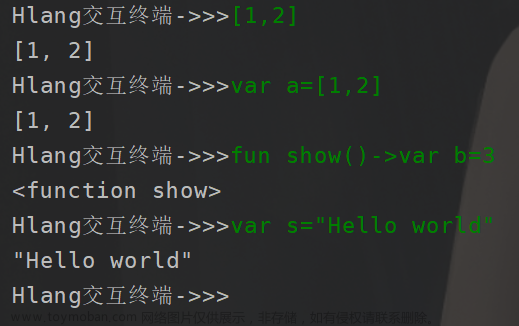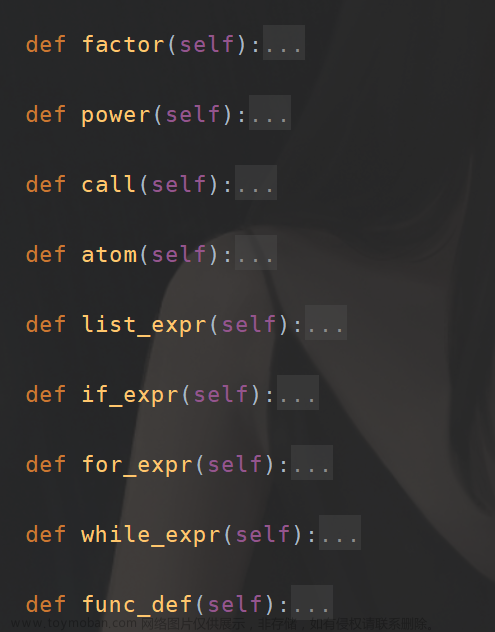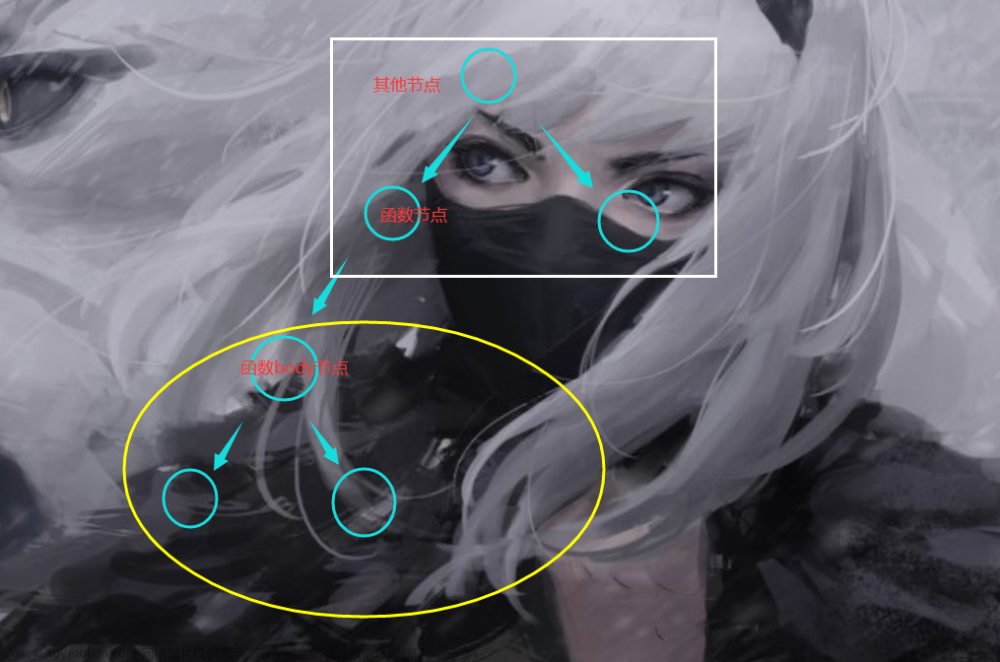前言
okey,经过一段时间的努力,接下来要实现的是函数。当然还有对应的基本数据结构,那么之后的话,我们的工作就开始进一步转换了。
那么在这块我们要实现的有:
- 函数的定义
- String类型的实现
- 列表类型的实现
实话实话,这个的实现是相当简陋的。不过作为一个小模型,应该是够用了,后面可以尝试打磨一下这个细节,比如这个变量的管理,函数的管理等等。
那么这块先看到我们的实现效果:
okey,我们开始吧。
语法表述
okey,现在的话,想要实现这个的话,我们需要先来看到我们的这个语法表述,前面我们一直在强调AST,因为这个玩意决定了,我们要如何愉快玩耍。
那么现在的话,我们来看到这个描述:
expr : KEYWORD:VAR IDENTIFIER EQ expr
: comp-expr ((KEYWORD:AND|KEYWORD:OR) comp-expr)*
comp-expr : NOT comp-expr
: arith-expr ((EE|LT|GT|LTE|GTE) arith-expr)*
arith-expr : term ((PLUS|MINUS) term)*
term : factor ((MUL|DIV) factor)*
factor : (PLUS|MINUS) factor
: power
power : call (POW factor)*
call : atom (LPAREN (expr (COMMA expr)*)? RPAREN)?
atom : INT|FLOAT|STRING|IDENTIFIER
: LPAREN expr RPAREN
: if-expr
: for-expr
: while-expr
: func-def
if-expr : KEYWORD:IF expr KEYWORD:THEN expr
(KEYWORD:ELIF expr KEYWORD:THEN expr)*
(KEYWORD:ELSE expr)?
for-expr : KEYWORD:FOR IDENTIFIER EQ expr KEYWORD:TO expr
(KEYWORD:STEP expr)? KEYWORD:THEN expr
while-expr : KEYWORD:WHILE expr KEYWORD:THEN expr
func-def : KEYWORD:FUN IDENTIFIER?
LPAREN (IDENTIFIER (COMMA IDENTIFIER)*)? RPAREN
ARROW expr
前面的都是老朋友,我们主要看到这个call,和func-def.
这两个家伙就是我们这个函数部分的操作。
这个和我们的变量实现一样,其实分两个部分,一个是函数本身的定义
例如Python的函数定义:
def add(a,b):
然后的话,是我们对函数的调用
add(a,b)
这里的话,其实是一样的。
所以的话,定义了这两个东西。
之后的话,我们来看到完整的描述:
expr:表示一个表达式。它可以是一个变量赋值表达式(以关键字 ‘VAR’ 开头),或者是一个比较表达式comp-expr,多个比较表达式之间可以使用逻辑运算符 ‘AND’ 和 ‘OR’ 进行连接。
comp-expr:表示一个比较表达式。它可以是一个逻辑非表达式(以关键字 ‘NOT’ 开头),或者是一个算术表达式arith-expr,多个算术表达式之间可以使用比较运算符进行比较。
arith-expr:表示一个算术表达式。它由一个项term开始,后面可以跟随多个加减运算符和项。
term:表示一个项。它由一个因子factor开始,后面可以跟随多个乘除运算符和因子。
factor:表示一个因子。它可以是正负号与另一个因子相乘的结果,或者是一个幂运算表达式power。
power:表示一个幂运算表达式。它由一个函数调用call开始,后面可以跟随多个幂运算操作。
call:表示一个函数调用。它由一个原子表达式atom开始,后面可以跟随一对括号和多个参数表达式。
atom:表示一个原子表达式。它可以是整数、浮点数、字符串或标识符,也可以是一个被括号包裹的表达式,或者是一个 if 表达式、for 循环表达式、while 循环表达式或函数定义表达式。
if-expr:表示一个 if 表达式。它以关键字 ‘IF’ 开头,后面跟随条件表达式、关键字 ‘THEN’ 和对应的表达式。之后可以有零个或多个关键字 ‘ELIF’、条件表达式和关键字 ‘THEN’ 和对应的表达式。最后可以有一个可选的关键字
‘ELSE’ 和对应的表达式。
for-expr:表示一个 for 循环表达式。它以关键字 ‘FOR’ 开头,后面跟随循环变量、赋值运算符、起始值、关键字 ‘TO’、结束值,然后可以是可选的关键字 ‘STEP’ 和步长值,最后是关键字 ‘THEN’ 和对应的表达式。
while-expr:表示一个 while 循环表达式。它以关键字 ‘WHILE’ 开头,后面跟随条件表达式,然后是关键字 ‘THEN’ 和对应的表达式。
func-def:表示一个函数定义表达式。它以关键字 ‘FUN’ 开头,后面可以是可选的标识符作为函数名称,然后是一对括号和多个参数标识符。最后是箭头符号和对应的表达式。
这样的话,就定义好了这个家伙。
解析器修改
okey,现在的话,开始来正式进入代码的编写部分。首先的话,毫无疑问的是,我们要做的是分为两个大部分,首先是对token词法解析的修改,然后是我们语法解析器的修改。当然这块的话我们就一起说了。
词法解析
首先,我们还是老规矩,去定义:
TT_INT = "整数"
TT_FLOAT = "浮点数"
TT_STRING = '字符串'
TT_PLUS = "加号"
TT_DIV = "除号"
TT_MINUS = "减号"
TT_LPAREN = "左括号"
TT_RPAREN = "右括号"
TT_POW = '次幂'
TT_MUL = "乘"
TT_EOF = 'EOF'
TT_IDENTIFIER = '设变量'
TT_KEYWORD = '关键字'
TT_EQ = '赋值'
TT_EE = '等于'
TT_NE = '不等于'
TT_LT = '小于'
TT_GT = '大于'
TT_LTE = '小于等于'
TT_GTE = '大于等于'
TT_LSQUARE = '[括号'
TT_RSQUARE = ']括号'
TT_COMMA = ',号'
TT_ARROW = '-> 符号'
KEYWORDS = [
'var',
'and',
'or',
'not',
'if',
'elif',
'else',
'for',
'to',
'step',
'while',
'fun',
'then'
]
可以看到,这个就是我们目前定义的关键字,还有对应的Token类型。
在解析器这里的话,我们要重新新增修改的代码不多,因为关键字匹配我们先前就是写好的,现在要做的只是匹配这个[]括号,主要是为了,处理这个列表变量。
当然还有这个:
这个家伙的话,可以去获取到我们的这个字符串,出现“ 这个符号的时候,我们就需要进行特殊处理了。
def make_string(self):
string = ''
pos_start = self.pos.copy()
escape_character = False
self.advance()
escape_characters = {
'n': '\n',
't': '\t'
}
while self.current_char != None and (self.current_char != '"' or escape_character):
if escape_character:
string += escape_characters.get(self.current_char, self.current_char)
else:
if self.current_char == '\\':
escape_character = True
else:
string += self.current_char
self.advance()
escape_character = False
self.advance()
return Token(TT_STRING, string, pos_start, self.pos)
函数节点
那么同样的,我们要加入这个函数节点。
这里的话,我们有两个:
FuncDefNode 类表示函数定义的节点。它具有以下属性:
var_name_tok:函数名称的记号(Token)。
arg_name_toks:参数名称的记号列表。
body_node:函数体的节点。
pos_start:节点在源代码中的起始位置。如果存在函数名记号,
则起始位置为该记号的起始位置;如果不存在函数名记号但存在参数名记号,
则起始位置为第一个参数名记号的起始位置;否则起始位置为函数体节点的起始位置。
pos_end:节点在源代码中的结束位置,等于函数体节点的结束位置。
CallNode 类表示函数调用的节点。它具有以下属性:
node_to_call:被调用的函数节点。
arg_nodes:参数节点列表。
pos_start:节点在源代码中的起始位置,等于被调用函数节点的起始位置。
pos_end:节点在源代码中的结束位置。如果存在参数节点,
则结束位置为最后一个参数节点的结束位置;否则结束位置为被调用函数节点的结束位置。
class FuncDefNode:
def __init__(self, var_name_tok, arg_name_toks, body_node):
self.var_name_tok = var_name_tok
self.arg_name_toks = arg_name_toks
self.body_node = body_node
if self.var_name_tok:
self.pos_start = self.var_name_tok.pos_start
elif len(self.arg_name_toks) > 0:
self.pos_start = self.arg_name_toks[0].pos_start
else:
self.pos_start = self.body_node.pos_start
self.pos_end = self.body_node.pos_end
class CallNode:
def __init__(self, node_to_call, arg_nodes):
self.node_to_call = node_to_call
self.arg_nodes = arg_nodes
self.pos_start = self.node_to_call.pos_start
if len(self.arg_nodes) > 0:
self.pos_end = self.arg_nodes[len(self.arg_nodes) - 1].pos_end
else:
self.pos_end = self.node_to_call.pos_en
函数节点解析
定义号函数节点之后的话,我们要做就是构建函数节点了,那么对于这个节点的处理,其实和我们的这个for循环,while 还有这个if的其实是类似的。
我们直接上代码吧,然后在注释里面说明:
def func_def(self):
res = ParseResult()
# 当前节处理是函数节点,检查有没有fun关键字
if not self.current_tok.matches(TT_KEYWORD, 'fun'):
return res.failure(InvalidSyntaxError(
self.current_tok.pos_start, self.current_tok.pos_end,
f"Expected 'fun'"
))
res.register_advancement()
self.advance()
# 处理函数的形式变量,也就是参数
# 问:为什么可以检查到下一个节点
# 答,算过了(狗头) 好吧是adanven这个函数,它会滑动,
# 这里面的话register其实是递归调用了,所以,前面结束之后,拿到的一定
# 就是符合语法规范的下一个token
if self.current_tok.type == TT_IDENTIFIER:
var_name_tok = self.current_tok
res.register_advancement()
self.advance()
#检查左括号
if self.current_tok.type != TT_LPAREN:
return res.failure(InvalidSyntaxError(
self.current_tok.pos_start, self.current_tok.pos_end,
f"Expected '('"
))
#没有参数
else:
var_name_tok = None
if self.current_tok.type != TT_LPAREN:
return res.failure(InvalidSyntaxError(
self.current_tok.pos_start, self.current_tok.pos_end,
f"Expected identifier or '('"
))
res.register_advancement()
self.advance()
arg_name_toks = []
# 处理参数
if self.current_tok.type == TT_IDENTIFIER:
arg_name_toks.append(self.current_tok)
res.register_advancement()
self.advance()
#下一个参数逗号隔开
while self.current_tok.type == TT_COMMA:
res.register_advancement()
self.advance()
if self.current_tok.type != TT_IDENTIFIER:
return res.failure(InvalidSyntaxError(
self.current_tok.pos_start, self.current_tok.pos_end,
f"Expected identifier"
))
arg_name_toks.append(self.current_tok)
res.register_advancement()
self.advance()
if self.current_tok.type != TT_RPAREN:
return res.failure(InvalidSyntaxError(
self.current_tok.pos_start, self.current_tok.pos_end,
f"Expected ',' or ')'"
))
# 没有参数了
else:
if self.current_tok.type != TT_RPAREN:
return res.failure(InvalidSyntaxError(
self.current_tok.pos_start, self.current_tok.pos_end,
f"Expected identifier or ')'"
))
res.register_advancement()
self.advance()
if self.current_tok.type != TT_ARROW:
return res.failure(InvalidSyntaxError(
self.current_tok.pos_start, self.current_tok.pos_end,
f"Expected '->'"
))
res.register_advancement()
self.advance()
node_to_return = res.register(self.expr())
if res.error: return res
# 完成参数节点定义,得到函数名,参数名(变量名)
return res.success(FuncDefNode(
var_name_tok,
arg_name_toks,
node_to_return
))
同样的,我们来看到call的实现。
def call(self):
res = ParseResult()
atom = res.register(self.atom())
if res.error: return res
"""
函数是可以有括号把里面的东西括起来的,就像这样:
fun show()-> ( var b=3 )
"""
if self.current_tok.type == TT_LPAREN:
res.register_advancement()
self.advance()
arg_nodes = []
if self.current_tok.type == TT_RPAREN:
res.register_advancement()
self.advance()
else:
arg_nodes.append(res.register(self.expr()))
if res.error:
return res.failure(InvalidSyntaxError(
self.current_tok.pos_start, self.current_tok.pos_end,
"Expected ')', 'var', 'if', 'for', 'while', 'fun', int, float, identifier, '+', '-', '(', '[' or 'not'"
))
while self.current_tok.type == TT_COMMA:
res.register_advancement()
self.advance()
arg_nodes.append(res.register(self.expr()))
if res.error: return res
if self.current_tok.type != TT_RPAREN:
return res.failure(InvalidSyntaxError(
self.current_tok.pos_start, self.current_tok.pos_end,
f"Expected ',' or ')'"
))
res.register_advancement()
self.advance()
# 当前面的都执行完毕之后的话,我们的这个Call节点就ok了。
return res.success(CallNode(atom, arg_nodes))
return res.success(atom)
他们着两个的关系其实就是这样的:
List的解析实现
ok, 这里别忘了,我们还实现了我们的数据结构,String和List,所以这里的话,我们还要对这个两个家伙处理。不过这块的话,对于String的话其实没有什么特殊的,只需要解释的时候进行处理,但是对于List的话,因为这个家伙是有语法规则的,因此还需要单独处理。
def list_expr(self):
res = ParseResult()
element_nodes = []
pos_start = self.current_tok.pos_start.copy()
if self.current_tok.type != TT_LSQUARE:
return res.failure(InvalidSyntaxError(
self.current_tok.pos_start, self.current_tok.pos_end,
f"Expected '['"
))
res.register_advancement()
self.advance()
if self.current_tok.type == TT_RSQUARE:
res.register_advancement()
self.advance()
else:
element_nodes.append(res.register(self.expr()))
if res.error:
return res.failure(InvalidSyntaxError(
self.current_tok.pos_start, self.current_tok.pos_end,
"Expected ']', 'var', 'if', 'for', 'while', 'fun', int, float, identifier, '+', '-', '(', '[' or 'not'"
))
while self.current_tok.type == TT_COMMA:
res.register_advancement()
self.advance()
element_nodes.append(res.register(self.expr()))
if res.error: return res
if self.current_tok.type != TT_RSQUARE:
return res.failure(InvalidSyntaxError(
self.current_tok.pos_start, self.current_tok.pos_end,
f"Expected ',' or ']'"
))
res.register_advancement()
self.advance()
return res.success(ListNode(
element_nodes,
pos_start,
self.current_tok.pos_end.copy()
))
这里的话,我特意把注释删掉了,按照我们前面的套路,我想应该是可以把这个看明白的。
解释器
之后是我们的解释器。
节点
同样的在我们的解释器里面也有节点,这个节点,前面忘记说了,先前的话我只要Number这个节点,主要是因为当时我们只有这个对数学的基本运算,没有啥高级的操作,因此一个就够了,这个玩意就是用来存储运算结果的。
同样的,现在的话,操作复杂了,因此我们要做的事情就多了,所以的话,在这里我们有这些玩意:
class Value:
def __init__(self):
self.set_pos()
self.set_context()
def set_pos(self, pos_start=None, pos_end=None):
self.pos_start = pos_start
self.pos_end = pos_end
return self
def set_context(self, context=None):
self.context = context
return self
def added_to(self, other):
return None, self.illegal_operation(other)
def subbed_by(self, other):
return None, self.illegal_operation(other)
def multed_by(self, other):
return None, self.illegal_operation(other)
def dived_by(self, other):
return None, self.illegal_operation(other)
def powed_by(self, other):
return None, self.illegal_operation(other)
def get_comparison_eq(self, other):
return None, self.illegal_operation(other)
def get_comparison_ne(self, other):
return None, self.illegal_operation(other)
def get_comparison_lt(self, other):
return None, self.illegal_operation(other)
def get_comparison_gt(self, other):
return None, self.illegal_operation(other)
def get_comparison_lte(self, other):
return None, self.illegal_operation(other)
def get_comparison_gte(self, other):
return None, self.illegal_operation(other)
def anded_by(self, other):
return None, self.illegal_operation(other)
def ored_by(self, other):
return None, self.illegal_operation(other)
def notted(self,other):
return None, self.illegal_operation(other)
def execute(self, args):
return RTResult().failure(self.illegal_operation())
def copy(self):
raise Exception('No copy method defined')
def is_true(self):
return False
def illegal_operation(self, other=None):
if not other: other = self
return RTError(
self.pos_start, other.pos_end,
'Illegal operation',
self.context
)
class Number(Value):
def __init__(self, value):
super().__init__()
self.value = value
def added_to(self, other):
if isinstance(other, Number):
return Number(self.value + other.value).set_context(self.context), None
else:
return None, Value.illegal_operation(self, other)
def subbed_by(self, other):
if isinstance(other, Number):
return Number(self.value - other.value).set_context(self.context), None
else:
return None, Value.illegal_operation(self, other)
def multed_by(self, other):
if isinstance(other, Number):
return Number(self.value * other.value).set_context(self.context), None
else:
return None, Value.illegal_operation(self, other)
def dived_by(self, other):
if isinstance(other, Number):
if other.value == 0:
return None, RTError(
other.pos_start, other.pos_end,
'Division by zero',
self.context
)
return Number(self.value / other.value).set_context(self.context), None
else:
return None, Value.illegal_operation(self, other)
def powed_by(self, other):
if isinstance(other, Number):
return Number(self.value ** other.value).set_context(self.context), None
else:
return None, Value.illegal_operation(self, other)
def get_comparison_eq(self, other):
if isinstance(other, Number):
return Number(int(self.value == other.value)).set_context(self.context), None
else:
return None, Value.illegal_operation(self, other)
def get_comparison_ne(self, other):
if isinstance(other, Number):
return Number(int(self.value != other.value)).set_context(self.context), None
else:
return None, Value.illegal_operation(self, other)
def get_comparison_lt(self, other):
if isinstance(other, Number):
return Number(int(self.value < other.value)).set_context(self.context), None
else:
return None, Value.illegal_operation(self, other)
def get_comparison_gt(self, other):
if isinstance(other, Number):
return Number(int(self.value > other.value)).set_context(self.context), None
else:
return None, Value.illegal_operation(self, other)
def get_comparison_lte(self, other):
if isinstance(other, Number):
return Number(int(self.value <= other.value)).set_context(self.context), None
else:
return None, Value.illegal_operation(self, other)
def get_comparison_gte(self, other):
if isinstance(other, Number):
return Number(int(self.value >= other.value)).set_context(self.context), None
else:
return None, Value.illegal_operation(self, other)
def anded_by(self, other):
if isinstance(other, Number):
return Number(int(self.value and other.value)).set_context(self.context), None
else:
return None, Value.illegal_operation(self, other)
def ored_by(self, other):
if isinstance(other, Number):
return Number(int(self.value or other.value)).set_context(self.context), None
else:
return None, Value.illegal_operation(self, other)
def notted(self):
return Number(1 if self.value == 0 else 0).set_context(self.context), None
def copy(self):
copy = Number(self.value)
copy.set_pos(self.pos_start, self.pos_end)
copy.set_context(self.context)
return copy
def is_true(self):
return self.value != 0
def __repr__(self):
return str(self.value)
class String(Value):
def __init__(self, value):
super().__init__()
self.value = value
def added_to(self, other):
if isinstance(other, String):
return String(self.value + other.value).set_context(self.context), None
else:
return None, Value.illegal_operation(self, other)
def multed_by(self, other):
if isinstance(other, Number):
return String(self.value * other.value).set_context(self.context), None
else:
return None, Value.illegal_operation(self, other)
def is_true(self):
return len(self.value) > 0
def copy(self):
copy = String(self.value)
copy.set_pos(self.pos_start, self.pos_end)
copy.set_context(self.context)
return copy
def __repr__(self):
return f'"{self.value}"'
class List(Value):
def __init__(self, elements):
super().__init__()
self.elements = elements
def added_to(self, other):
new_list = self.copy()
new_list.elements.append(other)
return new_list, None
def subbed_by(self, other):
if isinstance(other, Number):
new_list = self.copy()
try:
new_list.elements.pop(other.value)
return new_list, None
except:
return None, RTError(
other.pos_start, other.pos_end,
'Element at this index could not be removed from list because index is out of bounds',
self.context
)
else:
return None, Value.illegal_operation(self, other)
def multed_by(self, other):
if isinstance(other, List):
new_list = self.copy()
new_list.elements.extend(other.elements)
return new_list, None
else:
return None, Value.illegal_operation(self, other)
def dived_by(self, other):
if isinstance(other, Number):
try:
return self.elements[other.value], None
except:
return None, RTError(
other.pos_start, other.pos_end,
'Element at this index could not be retrieved from list because index is out of bounds',
self.context
)
else:
return None, Value.illegal_operation(self, other)
def copy(self):
copy = List(self.elements[:])
copy.set_pos(self.pos_start, self.pos_end)
copy.set_context(self.context)
return copy
def __repr__(self):
return f'[{", ".join([str(x) for x in self.elements])}]'
class Function(Value):
def __init__(self, name, body_node, arg_names):
super().__init__()
self.name = name or "<anonymous>"
self.body_node = body_node
self.arg_names = arg_names
def execute(self, args):
res = RTResult()
interpreter = Interpreter()
new_context = Context(self.name, self.context, self.pos_start)
new_context.symbol_table = SymbolTable(new_context.parent.symbol_table)
if len(args) > len(self.arg_names):
return res.failure(RTError(
self.pos_start, self.pos_end,
f"{len(args) - len(self.arg_names)} too many args passed into '{self.name}'",
self.context
))
if len(args) < len(self.arg_names):
return res.failure(RTError(
self.pos_start, self.pos_end,
f"{len(self.arg_names) - len(args)} too few args passed into '{self.name}'",
self.context
))
for i in range(len(args)):
arg_name = self.arg_names[i]
arg_value = args[i]
arg_value.set_context(new_context)
new_context.symbol_table.set(arg_name, arg_value)
value = res.register(interpreter.visit(self.body_node, new_context))
if res.error: return res
return res.success(value)
def copy(self):
copy = Function(self.name, self.body_node, self.arg_names)
copy.set_context(self.context)
copy.set_pos(self.pos_start, self.pos_end)
return copy
def __repr__(self):
return f"<function {self.name}>"
函数名非常直接。同时的话,在看到函数节点,还有这个执行的操作。
函数操作
我们先来看到我们的函数处理:
在我们的解释器部分有这个代码:
我们把这个函数相关的信息,进行组装,然后得到这个函数对象,然后通过函数对象进行操作。得到结果,或者运行函数里面的代码。
所以在这里的话,我们要重点看到这里,函数的执行代码:
可以看到,我们在这里的操作,是,我们得到了函数主体的入口节点,画图题可能是这样的:
我们的execute函数会拿到这个body,当然还有参数,然后我们让解释器,从这个body头节点开始执行
然后就是我们的局部参数,可以看到我们的代码在这里面:
for i in range(len(args)):
arg_name = self.arg_names[i]
arg_value = args[i]
arg_value.set_context(new_context)
new_context.symbol_table.set(arg_name, arg_value)
我们把这个变量的值什么的都放在了函数内部的局部context里面,所以这个就是局部参数的由来,我们在这里面实现了变量的隔离。
okey,接下来我们看到这个完整代码:
def execute(self, args):
res = RTResult()
interpreter = Interpreter()
new_context = Context(self.name, self.context, self.pos_start)
new_context.symbol_table = SymbolTable(new_context.parent.symbol_table)
if len(args) > len(self.arg_names):
return res.failure(RTError(
self.pos_start, self.pos_end,
f"{len(args) - len(self.arg_names)} too many args passed into '{self.name}'",
self.context
))
if len(args) < len(self.arg_names):
return res.failure(RTError(
self.pos_start, self.pos_end,
f"{len(self.arg_names) - len(args)} too few args passed into '{self.name}'",
self.context
))
for i in range(len(args)):
arg_name = self.arg_names[i]
arg_value = args[i]
arg_value.set_context(new_context)
new_context.symbol_table.set(arg_name, arg_value)
value = res.register(interpreter.visit(self.body_node, new_context))
if res.error: return res
return res.success(value)
String和List处理
接下来的话,就是String和List的处理,这里面的话没啥,直接看到代码就好了。文章来源:https://www.toymoban.com/news/detail-658812.html
def visit_StringNode(self, node, context):
return RTResult().success(
String(node.tok.value).set_context(context).set_pos(node.pos_start, node.pos_end)
)
def visit_ListNode(self, node, context):
res = RTResult()
elements = []
for element_node in node.element_nodes:
elements.append(res.register(self.visit(element_node, context)))
if res.error: return res
return res.success(
List(elements).set_context(context).set_pos(node.pos_start, node.pos_end)
)
总结
接下来的话,我们的实现就要到尾声了,当然接下来我们要处理的是这个,怎么和中文联系起来。先前我们一直做到的是中文,但是在后面,发现用中文实在是太啰嗦了,但是这个玩意的目标用户又是小学生,淦。文章来源地址https://www.toymoban.com/news/detail-658812.html
到了这里,关于Hlang--用Python写个编程语言-函数与基本数据结构实现的文章就介绍完了。如果您还想了解更多内容,请在右上角搜索TOY模板网以前的文章或继续浏览下面的相关文章,希望大家以后多多支持TOY模板网!








